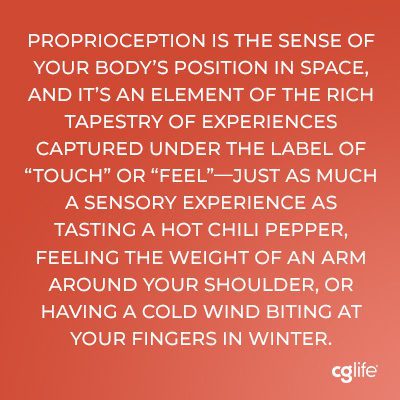The sense of touch, in my opinion, often gets overlooked compared to the other four senses. A kid listing the five senses almost never puts “touch” first—you have eyes, ears, a nose, and a tongue for the other four, which seem a tad more notable than…skin. But when I started learning more about sensory mechanisms in my first year of graduate school, I had a new favorite sense and a new appreciation for how much more it is than just “touch.”

Considering how important it is to the experience of moving through the world, I’m embarrassed to say I’d never thought about proprioception much until that class in graduate school. Proprioception is the sense of your body’s position in space, and it’s an element of the rich tapestry of experiences captured under the label of “touch” or “feel”—just as much a sensory experience as tasting a hot chili pepper, feeling the weight of an arm around your shoulder, or having a cold wind biting at your fingers in winter. The physical receptors that make all these experiences possible are being recognized by this year’s Nobel Prize in Physiology or Medicine, so let’s take a walk through the journey of scientific discoveries that brought us here.
From Descartes to Erlanger & Gasser
For centuries, scientists questioned how physical touch on the skin is translated to more complex sensory experiences of hot or cold, heavy or delicate, painful or pleasant. The research celebrated by the 1944 Nobel Prize in Physiology or Medicine paved the way for this year’s award and provides a great starting point for a cursory history of research in sensation. Joseph Erlanger and Herbert Gasser were celebrated in 1944 for the discovery of different varieties of sensory nerve fibers that are responsible for distinct types of sensation, such as painful or non-painful touch. They were able to show that neurons broadly fell into several classes stimulated by specific types of stimuli and conducting electrical signals at specific speeds.
How Peppers Get Their Heat

Further research then explored how even more specialized sensations are translated from receptors in the skin to nerve fiber to the brain—a progression that brings us to David Julius, Ph.D., one half of this year’s Nobel team. Julius sought to understand how capsaicin, the compound found in chili peppers that gives them their kick, actually works its magic. By identifying the gene encoding TRPV1, the protein that made cells responsive to capsaicin, Julius and his colleagues were able to isolate this novel ion channel protein in 1997. In addition to responding to capsaicin, the channel responded to actual heat—specifically, temperatures over 43 degrees Celsius, allowing the channel’s stimulation to communicate noxious temperatures and give chili peppers their burning sensation.
After TRPV1, Julius’ team went on to identify TRPM8, a receptor activated by cold and menthol, and TRPA1, the “wasabi receptor.” These and other sensory receptors have been critical in our understanding of pain and inflammation and, in turn, ways to treat them. Still, scientists didn’t know the receptors behind the basic mechanical sensation of touch, and, as it turns out, proprioception.
Proprioception and Piezo Channels
In 2013, a Canadian teenager presented to a neurologist from the US National Institute of Neurological Disorders and Stroke with a unique complaint: she seemed to lack control over her limbs. Particularly when her eyes were closed, the young woman’s limbs squirmed as if she had no sense of their position in space, an understandably disruptive issue. After sequencing the genes of this and a similar patient, the research team found mutations in a gene called PIEZO2. Only two years prior, the ion channel proteins encoded by PIEZO2 and a related gene, PIEZO1, were found to respond to mechanical stimulation. The team responsible for this discovery was led by the second half of this year’s Nobel Prize in Physiology or Medicine, Ardem Patapoutian, Ph.D.
The mechanism behind these channels was revealed through advances in cryo-electron microscopy (which were recognized in 2017 with the Nobel Prize in Chemistry). Three Piezo proteins unite to form a three-bladed structure around an open pore in the cell membrane. Tension on the cell membrane can move these blades, opening the channel and allowing ions to flow through for signaling. In addition to helping us feel a caress or a pinprick on the skin, Piezos and other mechanosensitive receptors communicate important bodily signals. They translate the forces of gravity on bones and muscles (i.e., proprioception), the pressure in organs such as the stomach or bladder, and the force of sound waves on cells in the inner ear. In short, they’re pretty important.
A New Appreciation for Touch
The announcement of Julius and Patapoutian’s award by the Nobel Assembly noted, “The groundbreaking discoveries of the TRPV1, TRPM8 and Piezo channels by this year’s Nobel Prize laureates have allowed us to understand how heat, cold, and mechanical force can initiate the nerve impulses that allow us to perceive and adapt to the world around us.” Learning more about the intricacies of our sense of “touch” quickly made it my favorite sense. More importantly, it highlighted the incredible mechanisms behind our basic human experiences that made me love neuroscience in the first place.
